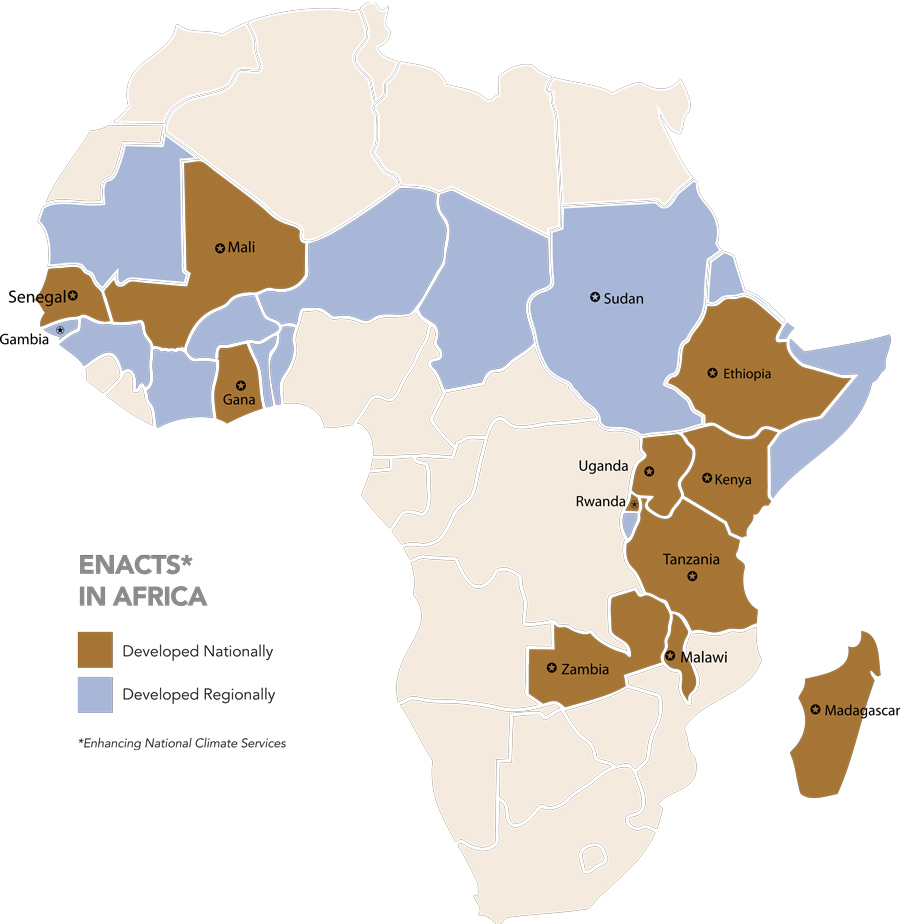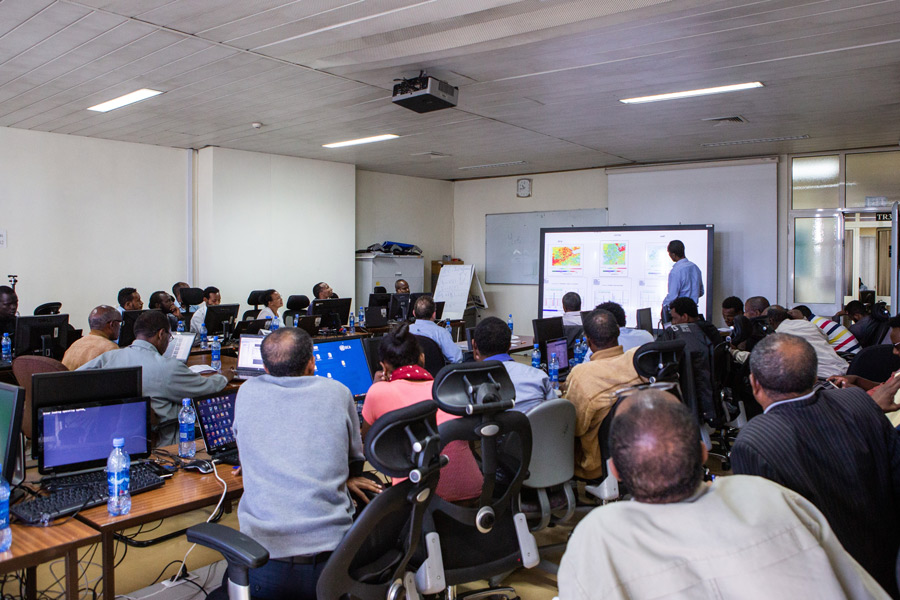ENACTS: Risk, Resilience, and the Revitalisation of Climate Services in the Developing World
The consequences of climate change are vast. While the term “global warming” is sometimes used, in fact climate change means far more than just warmer temperatures: changes in rainfall, more extreme weather events, and disrupted seasons and livelihoods are just some of the repercussions already being felt.
To stand a chance of meeting the immense challenges created by year-to-year climate variability and long-term climate change, governments, organisations, and communities need valid, reliable, and actionable climate information upon which to base decisions. Availability of robust climate data is an essential first step in planning for, and managing, the risks of climate variability and change, but must also be accompanied by measures to ensure equitable access and effective use.

The value of climate data
Quality climate data (historical, current, and forecast) is foundational for the provision of effective climate services and management of risk. In Africa, for example, where many nations depend on rain-fed agriculture for their livelihoods and economic well-being, climate data is a critical input for decisions and programmes designed to build resilience of those with poor adaptive capacity but most acutely affected by changing precipitation and temperature patterns. Here and elsewhere, appropriate and adequate availability, access, and use of climate data benefit agriculture and other economic activities in a variety of ways, by equipping decision-makers with the information they need to inform critical preparatory, monitoring, and response measures. By consulting local historical climate data records, for instance, a decision-maker can better understand the drivers of climate variability and change, determine whether perceived changes in performance in a sector like agriculture are truly driven by climate or other factors, and take appropriate action. More concretely, armed with high-quality local meteorological observations and forecasts integrated with other information such as crop simulation models, a decision-maker can dramatically improve food security early warning and response by increasing the lead time and accuracy of forecasts instrumental to these efforts.

Climate data challenges in Africa
In many parts of Africa, availability of and access to quality climate data is patchy. The reasons for this limited availability of data are varied but include a lack of investment in or maintenance of climate-monitoring infrastructure such as weather stations, as well as disruptions due to civil unrest. The case of Rwanda provides perhaps the most poignant and famous example of the latter. The civil war and genocide that devastated the country in 1994, including its meteorological observation system, led to a gap in the weather record of almost 15 years.
In relation to infrastructure, in many African countries, weather stations are few and far between, and when existing, often poorly maintained. In some places, it is the number of stations that is most problematic. There has been a consistent decline in the availability of weather observations across the continent, with their costly nature and requirements for trained individuals in a severely resource constrained environment largely to blame. In other places, even when numbers of stations are adequate, their distribution proves problematic: most stations tend to be located in towns and along major roads, poorly covering and representing the most rural areas.
Whatever their ultimate cause, these issues mean that governments and other organisations simply do not have the information they need to effectively tackle the challenges of climate variability and change.
To meet the immense challenges created by climate, governments, organisations and communities need high-quality, relevant, and actionable climate information.
ENACTS: Bridging the gap
To help meet the current and coming challenges, gaps in climate data and information, as well as in the human capacities to take advantage of them, must be filled. With this aim, Columbia University’s International Research Institute for Climate and Society (IRI), in close collaboration with local partners, launched the Enhancing National Climate Services (ENACTS) initiative in 2012.
Availability
The goal of ENACTS is to improve the availability of high-quality climate data, through the combination of quality-controlled national meteorological observations with the best of global climate observations. To accomplish this, ENACTS has been working closely with the National Meteorological and Hydrological Services (NMHS) of various African countries. These organisations have the responsibility of collecting and managing climate data at the national level. To help NMHS improve their data quality and availability, ENACTS has developed and implemented a tool for quality-control of rainfall and temperature observations collected by national weather stations, and then blends these observations with freely available global products. For example, rainfall observations collected by stations are combined with satellite rainfall estimates. In this way, the limitation of the patchy coverage of national weather stations is corrected by the use of globally available data; at the same time, the rainfall estimates from satellite data are enhanced by the more accurate weather station observations. This accomplished using IRI’s Climate Data Tool (CDT), which is installed at each NMHS.

Access
Beyond availability, ENACTS is facilitating better access to climate information and promoting the wider use of climate information in decision-making by governments as well as the public and private sectors. ENACTS is achieving these aims by creating targeted climate information products, each of which is co-generated and tailored to the requirements of the user, whether that is at a local, national, or international level. Moreover, it is making these products available through an interactive web portal owned and hosted through each NMHS. A key platform supporting this is the IRI Data Library, which is a powerful and freely accessible online data repository and analysis tool that allows users to view, analyse, and download, and share hundreds of terabytes of multidisciplinary climate-related data through a standard web browser. The Data Library is provided to each NMHS and can be used to develop automated interactive tools to meet the particular needs of the NMHS and users.
Use
Just because climate information is freely available and accessible does not ensure that it is usable. Use of climate information is therefore promoted by ENACTS through awareness-raising, targeted capacity building, and sustained engagement with the user community. The first step would be making potentials users aware of the resources available to them. The ENACTS team holds workshops and other outreach events for stakeholders including policymakers, researchers, academics, and journalists. Sustained engagement with stakeholders, and, perhaps most importantly, the co-development of the information products with users themselves is critical to ensure their relevance to each unique context, and local ownership and championing of the information and derived tools in each setting.
Implementing ENACTS
In practice, ENACTS is able to support NMHS by providing expertise and resources that are beyond the capacity of these national-level organisations.
Members of the ENACTS team at the IRI visit each NMHS and work closely with the staff to implement ENACTS. This can include offering methods, tools, and training. For example, the ENACTS team might assist the NMHS with completing historical climate data sets, creating climate information products, and making those products available through interactive online platforms.

One key outcome of the implementation of ENACTS is that countries partaking in the initiative develop consistent and comparable sets of climate data, which has been subject to a robust quality control process. Missing or anomalous data can be addressed. Weather station locations are also checked for accuracy and corrected where necessary. While this process is time consuming, it ensures future data will be of high quality.
ENACTS is designed as an ongoing process to improve climate services in an incremental and iterative way.
Moreover, a simple yet effective statistical software package (CDT) introduced by ENACTS allows NMHS to analyse and visualise their data in new ways; in many cases, this allowed NMHS an insight into their data that had not previously been available.
Evolution of ENACTS
Since its launch in Ethiopia in 2012, ENACTS has been implemented at the national level in over a dozen countries, as well as at the broader regional level in East and West Africa as we all as few countries in Asia and Latin America. Over that time, ENACTS has proven to be effective in strengthening climate services at the national level. However, Dr Tufa Dinku and his colleagues recognise that there is still room to expand and improve many aspects of the ENACTS initiative. In countries where ENACTS has already been implemented, it can be enhanced; elsewhere, the African countries in which ENACTS has not yet been established can be targeted.
Strengthening ENACTS will involve not only improving the initiative where it already exists but expanding several different aspects of the initiative. For example, data generated through ENACTS could be enhanced by including more climate variables, such as humidity and daily hours of sunshine. In addition, some users have asked for climate products that are more relevant to the specific decisions they need to make. An organisation focused on health, for example, might require specific data and product relating to water supply, to better understand the spread of waterborne diseases.
Finally, the area most in need of development is the expanded use of the ENACTS data and information products into new geographies and sectors. While it was initially hoped that the NMHS would be able to lead on promotion of climate information products, in reality, progress has been slow due to inertia surrounding long-standing norm of NMHS only providing limited products such as weather and seasonal forecasts. To address this challenge, Dr Dinku and his colleagues acknowledge the need to evolve their approach to involve additional sectoral experts besides the NMHS in the promotion of ENACTS. This will broaden the conversation and support national and international dialogue and momentum for the incorporation of effective climate services in all corners and sectors affected by climate.

ENACTS is not intended to be a one-time project. Instead, ENACTS is designed as an ongoing, iterative process to improve climate services in an incremental and continuous way. As the team behind ENACTS continues to improve the initiative, it will, at the same time, work to expand its reach. While ENACTS has yet to be established in large parts of Africa, the team hopes that, by partnering with national and international organisations including Regional Climate Centers, the initiative will continue to expand.
Building resilience is vital if countries and communities are to cope with the challenges of climate variability and change. This is particularly important in those parts of the world, like Africa, which are expected to be bear the brunt of the impacts of a shifting climate but are currently least equipped with adaptive capacities manage new risks. By providing high-quality climate services through the improved availability, access, and use of climate information, ENACTS is equipping governments and other organisations with the skills and resources they need to plan for and manage the negative effects of a changing climate, while harnessing new opportunities through adaptation.
Personal Response
How can ENACTS expand to more countries?
<> Most African countries, if not all, will greatly benefit from ENACTS’ innovative approach. By its nature, ENACTS lays the foundation for the implementation of the National Framework for Climate Sevices (NFCS). While the efforts of the IRI, NMHS, and development partners offer a strong practical example of climate services development in Africa, substantial funding and collaboration with national, regional, and global organisations will be needed to expand ENACTS across Africa, and beyond. The expansion can be made cost effective and more sustainable by building technical capacity within the continent. This has already started at the IGAD Climate Prediction and Application Center (ICPAC) in East Africa and at the AGRHYMET Regional Center in West Africa.